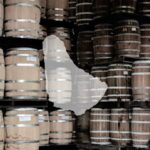Reunion Island rum, get to the bottom of the bottle
Why does a rum from Réunion Island develop this aromatic profile? Let’s go from the bottle to the cane to find out.

Photo d’illustration © Anne Gisselbrecht
Weren’t you at your local rum cellar a while ago? Your thirst for knowledge knows no bounds! Anyway, here you are again, in search of cane brandy and knowledge. Fortunately, your official supplier is not short of either.
Having not yet had the opportunity to discover the rums of the Indian Ocean, you mention them to your cellarman, who – in no time at all – starts telling you about Réunion Island and the highly unusual profile of the cane brandies produced there.
You’re a little surprised by his enthusiasm, which doesn’t quite fit in with the image of an island known for its rhums arrangés. Not that you have anything against arranged rums, but that’s not what you’re looking for.
So, once again, you follow the expert advice of your specialist wine merchant and leave with a bottle made in Réunion.
When you get home, close the door, take off your shoes, relieve your bladder and wash your hands (in that order), you take out a tasting glass – you know those ‘tulip’ glasses – which you fill (no, not all the way) with the freshly acquired rum.
You are immediately struck by its highly expressive, even full-bodied nature. The fruit is front and centre, and you’re intrigued by a novel empyreumatic note.
Behind these aromas that literally jump out at you, you detect spicy notes (including a nice vanilla), as well as a hint of roast.
It’s an identity you didn’t know you had, and that excites you (calm down!).
The nose and palate point you in the direction of molasse. And you’re right. Most of the rums produced on Réunion use molasses as a raw material.
However, the island’s three main distilleries (Isautier, Savanna and Rivière du Mât) also produce a small quantity of rhum agricole.
Of course, the roasted and spicy notes come from the ageing process, the key stage in the production of an aged rum, during which exchanges between the juice and the wood take place. These include the aromas from the cask, which gradually colonise the liquid.
On the other hand, the fruity, empyreumatic profile (a superb word that will help you to shine in society), has its origins in the production stages of white rum. It’s the combination of several factors that explains it: the terroir in which the cane grows, the methods used to produce the sugar (and therefore the molasses) and the fermentation.
Reunion’s white rum has a strong character. It exudes fruity and floral aromas, as well as aromas of fermentation, such as olives in brine. It also often expresses that very special characteristic that can make you think of heated rubber. The whole is very expressive and quite unique.
Yes, you’ll have to buy a bottle of white rum to see for yourself!
This strong identity means that it can be aged without the wood totally overpowering the distillate.
It’s worth noting – and this is quite rare in the world of rum – that a large part of the island’s ageing is carried out in French oak barrels (new or that have contained cognac). This is where the spices that characterise Réunion’s aged rums find their roots.
Another important point is that Réunion Island rums have a geographical indication. Similar to that of Guadeloupe, it ensures quality and typicality without being too restrictive.
The first criterion for a rum to bear the label “Rhum de la Réunion” is that it is a traditional rum.
A lot of people make the mistake of calling molasses rums “traditional rums“, even though this term has a legal definition in European law. It describes rums that meet the following four criteria:
- The raw material must originate from the place of production
- The percentage by volume of distillation must be less than 90% vol
- The volatile substances content (or non-alcohol content) must be equal to or greater than 225 grams per hectolitre of pure alcohol (in simple terms, this is a measure of the intensity of the aromas).
- The rum must not be sweetened
In other words, the nature of the raw material is irrelevant. Rum can be both traditional and agricultural.
With that out of the way, let’s move on. Mind you, if I run into you and you make this mistake in my presence, you’re going to hear me!
I must mention a singular product, reminiscent of Jamaican rums: high esters. In fact, one of Réunion’s distilleries produces grand arôme, a rum with very special production methods (especially, but not only, in terms of fermentation).
Extremely aromatic, it will leave no one indifferent and is a rum experience in itself. Here’s another avenue you’ll have to explore – it never ends…
Of course, you weren’t wrong to associate Réunion with rhum arrangé. A true national drink, you’ll find several Réunionese brands (either specialising in arrangés, or a distillery that devotes part of its range to them) selling their typical island creations.
I couldn’t talk about rum and Bourbon Island without mentioning these rum-based spirits (yes, that’s the official name for the category). If you have a sweet tooth and love fruit, you can’t miss them.
You now have a few essential points of reference for understanding and appreciating Réunion’s rums. So, after this molasses rum, why not try a Réunion agricultural rum?












